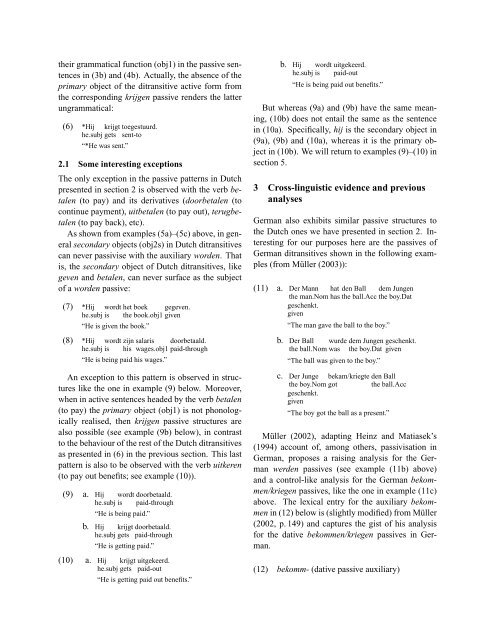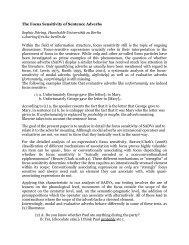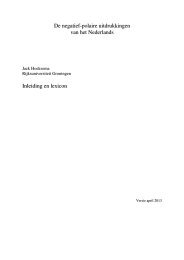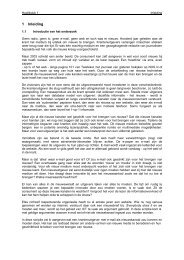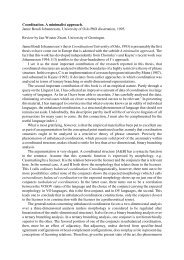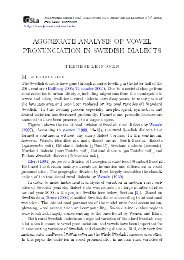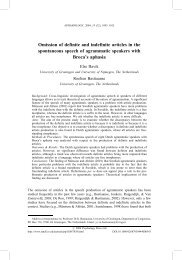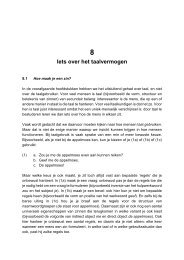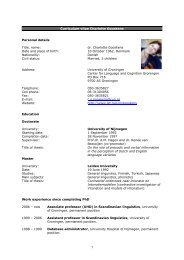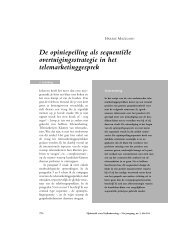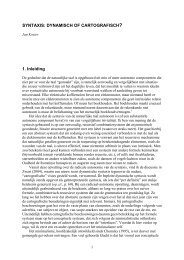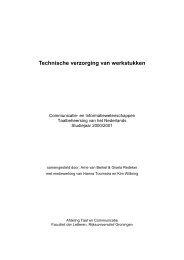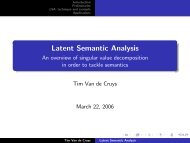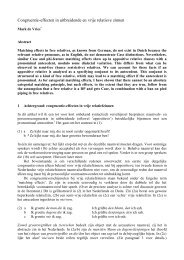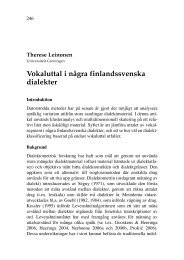Object-to-Subject Raising: An Analysis of the Dutch Passive
Object-to-Subject Raising: An Analysis of the Dutch Passive
Object-to-Subject Raising: An Analysis of the Dutch Passive
You also want an ePaper? Increase the reach of your titles
YUMPU automatically turns print PDFs into web optimized ePapers that Google loves.
<strong>the</strong>ir grammatical function (obj1) in <strong>the</strong> passive sentences<br />
in (3b) and (4b). Actually, <strong>the</strong> absence <strong>of</strong> <strong>the</strong><br />
primary object <strong>of</strong> <strong>the</strong> ditransitive active form from<br />
<strong>the</strong> corresponding krijgen passive renders <strong>the</strong> latter<br />
ungrammatical:<br />
(6) *Hij krijgt <strong>to</strong>egestuurd.<br />
he.subj gets sent-<strong>to</strong><br />
“*He was sent.”<br />
2.1 Some interesting exceptions<br />
The only exception in <strong>the</strong> passive patterns in <strong>Dutch</strong><br />
presented in section 2 is observed with <strong>the</strong> verb betalen<br />
(<strong>to</strong> pay) and its derivatives (doorbetalen (<strong>to</strong><br />
continue payment), uitbetalen (<strong>to</strong> pay out), terugbetalen<br />
(<strong>to</strong> pay back), etc).<br />
As shown from examples (5a)–(5c) above, in general<br />
secondary objects (obj2s) in <strong>Dutch</strong> ditransitives<br />
can never passivise with <strong>the</strong> auxiliary worden. That<br />
is, <strong>the</strong> secondary object <strong>of</strong> <strong>Dutch</strong> ditransitives, like<br />
geven and betalen, can never surface as <strong>the</strong> subject<br />
<strong>of</strong> a worden passive:<br />
(7) *Hij wordt het boek gegeven.<br />
he.subj is <strong>the</strong> book.obj1 given<br />
“He is given <strong>the</strong> book.”<br />
(8) *Hij wordt zijn salaris doorbetaald.<br />
he.subj is his wages.obj1 paid-through<br />
“He is being paid his wages.”<br />
<strong>An</strong> exception <strong>to</strong> this pattern is observed in structures<br />
like <strong>the</strong> one in example (9) below. Moreover,<br />
when in active sentences headed by <strong>the</strong> verb betalen<br />
(<strong>to</strong> pay) <strong>the</strong> primary object (obj1) is not phonologically<br />
realised, <strong>the</strong>n krijgen passive structures are<br />
also possible (see example (9b) below), in contrast<br />
<strong>to</strong> <strong>the</strong> behaviour <strong>of</strong> <strong>the</strong> rest <strong>of</strong> <strong>the</strong> <strong>Dutch</strong> ditransitives<br />
as presented in (6) in <strong>the</strong> previous section. This last<br />
pattern is also <strong>to</strong> be observed with <strong>the</strong> verb uitkeren<br />
(<strong>to</strong> pay out benefits; see example (10)).<br />
(9) a. Hij wordt doorbetaald.<br />
he.subj is paid-through<br />
“He is being paid.”<br />
b. Hij krijgt doorbetaald.<br />
he.subj gets paid-through<br />
“He is getting paid.”<br />
(10) a. Hij krijgt uitgekeerd.<br />
he.subj gets paid-out<br />
“He is getting paid out benefits.”<br />
b. Hij wordt uitgekeerd.<br />
he.subj is paid-out<br />
“He is being paid out benefits.”<br />
But whereas (9a) and (9b) have <strong>the</strong> same meaning,<br />
(10b) does not entail <strong>the</strong> same as <strong>the</strong> sentence<br />
in (10a). Specifically, hij is <strong>the</strong> secondary object in<br />
(9a), (9b) and (10a), whereas it is <strong>the</strong> primary object<br />
in (10b). We will return <strong>to</strong> examples (9)–(10) in<br />
section 5.<br />
3 Cross-linguistic evidence and previous<br />
analyses<br />
German also exhibits similar passive structures <strong>to</strong><br />
<strong>the</strong> <strong>Dutch</strong> ones we have presented in section 2. Interesting<br />
for our purposes here are <strong>the</strong> passives <strong>of</strong><br />
German ditransitives shown in <strong>the</strong> following examples<br />
(from Müller (2003)):<br />
(11) a. Der Mann hat den Ball dem Jungen<br />
<strong>the</strong> man.Nom has <strong>the</strong> ball.Acc <strong>the</strong> boy.Dat<br />
geschenkt.<br />
given<br />
“The man gave <strong>the</strong> ball <strong>to</strong> <strong>the</strong> boy.”<br />
b. Der Ball wurde dem Jungen geschenkt.<br />
<strong>the</strong> ball.Nom was <strong>the</strong> boy.Dat given<br />
“The ball was given <strong>to</strong> <strong>the</strong> boy.”<br />
c. Der Junge bekam/kriegte den Ball<br />
<strong>the</strong> boy.Nom got <strong>the</strong> ball.Acc<br />
geschenkt.<br />
given<br />
“The boy got <strong>the</strong> ball as a present.”<br />
Müller (2002), adapting Heinz and Matiasek’s<br />
(1994) account <strong>of</strong>, among o<strong>the</strong>rs, passivisation in<br />
German, proposes a raising analysis for <strong>the</strong> German<br />
werden passives (see example (11b) above)<br />
and a control-like analysis for <strong>the</strong> German bekommen/kriegen<br />
passives, like <strong>the</strong> one in example (11c)<br />
above. The lexical entry for <strong>the</strong> auxiliary bekommen<br />
in (12) below is (slightly modified) from Müller<br />
(2002, p. 149) and captures <strong>the</strong> gist <strong>of</strong> his analysis<br />
for <strong>the</strong> dative bekommen/kriegen passives in German.<br />
(12) bekomm- (dative passive auxiliary)


